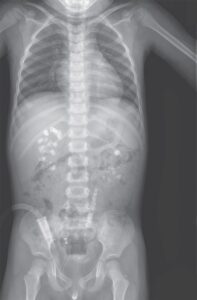A physical examination was notable for blue-black discoloration of the distal second through fifth fingers of the left hand, dusky discoloration of several fingers of the right hand, purpuric lesions on both hands, and similar discoloration on the toes of both feet.
There was associated edema but no sclerodactyly or telangiectasias. Radial, posterior tibial, and dorsalis pedis pulses were palpable on both sides.
Laboratory tests revealed normal renal and liver function and an elevated C-reactive protein level of 12.29 mg per deciliter (normal value, <0.3).
Necrosis of the fingers and toes has a broad differential diagnosis, including:
- vasculitis
- infection
- arterial embolism
- thrombophilia
Tests for antineutrophil cytoplasmic antibodies, antinuclear antibodies, antiphospholipid antibodies, cryoglobulin, hepatis B virus, and cold agglutinin were negative. Blood cultures showed no growth, and transesophageal echocardiography revealed no valvular vegetations.
Given the clinical concern about vasculitis, treatment with glucocorticoids was initiated, and a biopsy of the lesions on a finger and toe was performed.
The biopsy specimens showed fibrinoid necrosis, inflammation, and medial thickening in a medium-sized artery, findings that are consistent with a diagnosis of polyarteritis nodosa, a medium-vessel vasculitis.
The symptoms of fever and malaise diminished with treatment, which included the addition of azathioprine, and the level of C-reactive protein normalized. The necrotic areas of the fingers were amputated, and the remaining fingers and toes recovered completely.

